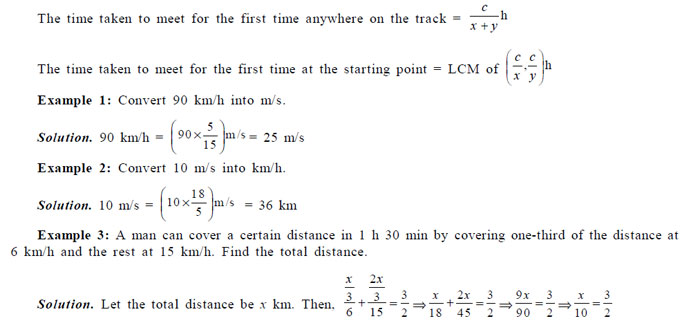(Study Materials) Numerical Ability/Quantitative Aptitude : Time and Distance
(Study Materials) Numerical Ability/Quantitative Aptitude : Time and Distance
Time and Distance
Relation between Time, Speed and Distance
Distance covered, time and speed are related by
Time =
 ...(i)
...(i)
Speed =
 ...(ii)
...(ii)
Distance = Speed × Time ...(iii)
- Distance is measured in metres, kilometres and miles.
- Time in hours, minutes and seconds.
- Speed in km/h, miles/h and m/s.
1. To convert speed of an object from km/h to m/s multiply the speed by . 5/18
2. To convert speed of an object from m/s to km/h, multiply the speed by . 18/5
Average Speed
It is the ratio of total distance covered to total time of journey.
Average Speed =

General Rules for Solving Time & Distance Problems
Rule 1
If a certain distance is covered with a speed of ‘x’ km/h and another equal distance with a speed of ‘y’ km/h, then the average speed for the whole journey is the harmonic mean of the two speeds.

Rule 2
If three equal distances are covered by three different speeds x, y and z km/h, then average speed for the whole journey is given by

Rule 3
If a certain distance is covered with a speed of ‘x’ km/h and another distance with a speed of ‘y’ km/ h but time interval for both journeys being same, then average speed for the whole journey is given by

Rule 4
If a certain distance is covered with a speed of x, y and z km/h, but time inverval for the three journey being equal, then average speed is given by

Rule 5
If the ratio of speeds A and B is x : y, then the ratio of times taken by them to cover the same distance is

Relative Speed
(i) If two bodies are moving in the same direction at x km/h and y km/h,
where (x > y), then their relative speed is given by (x – y) km/h.
(ii) If two bodies are moving in opposite direction at x km/h and y km/h, then
the their relative speed is given by (x + y) km/h.
General Rules for Solving Train Problems
Rule 1 Train Vs Stationary Object of no Length
Time taken by a train of length ‘l’ metre to pass a stationary object such as a pole, standing man or a building is equal to the time taken by the train to cover l metre.

Rule 2 Train Vs Stationary Object of Certain Length
Time taken by a train of length ‘l’ metre to pass a stationary object of length ‘a’ metre such as another standing train, bridge or railway platform is equal to the time taken by the train to cover (l + a) metre.

Rule 3 Train Vs Moving Object of no Length
Time taken by the train of length ‘l’ metre to pass a man moving is equal to the time taken by the train to cover l metre
(i) When the train and man move in the same direction with speeds of x m/s and y m/s. Then,

Rule 4 Train Vs Moving Object of Certain Length
Time taken by the train of length ‘l’ metre to pass a moving object of length ‘a’ metre such as another moving train is equal to the time taken by the train to cover (l + a) metre.
(i) When the two trains move in the same direction with speeds of x m/s and y m/s, (x > y), then

Rule 5 Two Moving Train
If two trains start at the same time from points A and B towards each other and after crossing they take a and b second in reaching B and A respectively. Then, (A’s speed) : (B’s speed) =

General Rules for Solving Boats and Streams Problem
Downstream Motion
When an object is moving against (opposite) direction in which the water in the stream is flowing, then the bject is said to be moving upstream.
Upstream Motion
When an object is moving against (opposite) direction in which the water in the stream is flowing, then the object is said to be moving upstream.
Motion in Still Water
When an object is moving in water where there is no motion in water, the object can move in any direction with a uniform speed, then the object is said to be moving in still water.
Rule 1 Downstream and Upstream Speed
Let the speed of the boat in still water = x km/h and speed of the stream be
y km/h, then
Speed of the boat with stream downstream speed = (x + y) km/h
Speed of the boat against stream = upstream speed = (x – y) km/h
As, when the boat is moving downstream, the speed of the water aids the speed of the boat and when the boat is moving upstream, the speed of the water reduces the speed of the boat.
Rule 2 Speed of Boat in Still Water & Speed of Stream
If the downstream speed of boat is a km/h and the upstream speed of boat is b km/h, then

General Rules for Solving Circular Tracks
Rule 1
When two people are running around a Circular Track starting at the same point and at the same time, then whenever the two people meet the person moving with a greater speed covers one round more than the person moving with lesser speed.
Rule 2
When two people with speeds of x km/h and y km/h start at the same time and from the same point in the same direction around a circular track of circumference ‘c’ km, then

Rule 3
When two people with speeds of x km/h and y km/h respectively start at the same time and from the same point but in opposite direction around a circular track of circumference ‘c’ km, then


